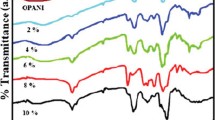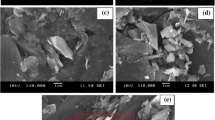Abstract
An easy process for the synthesis of polyaniline/graphite nanosheets (PANI/NanoG) composites was developed. NanoG were prepared by treating the expanded graphite with sonication in aqueous alcohol solution. Scanning electron microscopy (SEM), X-ray diffraction techniques (XRD), Fourier transform infrared (FT-IR), and transmission electron microscopy (TEM) were used to characterize the structures of NanoG and PANI/NanoG conducting composites. Electrical conductivity measurements indicated that the percolation threshold of PANI/NanoG composites at room temperature was as low as 0.32 vol.% and the conductivity of PANI/NanoG composites was 420 S/cm. The percolation theory, mean-field theory, and excluded volume theory were applied to interpret the conducting properties. Results showed that the low value of percolation threshold may be mainly attributed to nanoscale structure of NanoG forming conducting bridge in PANI matrix and there exists contact resistance in the percolation network formed within PANI/NanoG composites.









Similar content being viewed by others
References
Pinto G, Jimenez-Martin A (2001) Polym Compos 22:65
Hepel M (1998) J Electrochem Soc 145:124
Flandin L, Bidan G, Brechet Y, Cavaile JY (2000) Polym Compos 21:165
Wessling B, Posdorfer J (1999) Electrochim Acta 44:2053
Roldughin VI, Vysotskii VV (2000) Prog Org Coat 39:81
Sapurina I, Mokeev M, Lavrentev V (2000) Eur Polym J 36:2321
Wang DH, Qi SH, Wu YM (2009) J Appl Polym Sci 110:3162
Xiao P, Xiao M, Liu PG, Gong KC (2000) Carbon 38:623
Shioyama H, Tatsumi K, Iwashita N (1998) Synth Met 96:229
Xiao M, Sun L, Liu J (2002) Polymer 43:2245
Kirkpatrick S (1973) Rev Mod Phys 45:574
Carmona F (1989) Physica A 157:461
Celzard A, Mareche JF, Furdin G (2000) Phys D Appl Phys 33:3094
Lu W, Lin HF, Wu DJ (2006) Polymer 47:4440
Chen GH, Wu DJ, Weng WG (2001) Polym Int 50:980
Wenge Z, Shing CW (2002) Polymer 73:6767
Chen GH, Wu DJ, Weng WG (2001) Acta Polym Sin 6:803
Xiao P, Xiao M, Gong K (2001) Polymer 42:4813
Chen GH, Wu DJ, Weng WG (2001) J Appl Polym Sci 82:2506
Pan YX, Yu ZZ, Ou YC (2000) J Polym Sci Part B Polym Phys 38:1626
Tchmutin IA, Ponomarenko AT, Efimov ON (2003) Carbon 41:1391
Du XS, Xiao M, Meng YZ (2004) Eur Polym J 40:1489
Chen GH, Weng WG, Wu DJ (2004) Carbon 42:753
Chen GH, Weng WG, Wu DJ (2003) Eur Polym J 39:2329
Chen GH, Wu DJ, Weng WG (2003) Polymer 44:1781
Habsuda J, Simon GP, Cheng YB (2002) Polymer 44:4627
Wang JJ, Zhu MY, Outlaw-Ron A (2004) Carbon 42:2867
Mo ZL, Zuo DD, Chen H (2007) Eur Polym J 43:300
Stauffer D, Aharony A (1991) Introduction to percolation theory. Taylor & Francis, London
Helsing J, Helte A (1991) J Appl Phys 69:3583
Ruschau GR, Newnham RE (1992) J Compos Mater 26:2727
Balberg I, Anderson CH, Alexander S (1984) Phys Rev B 30:3933
Hu YH, Liu JF, Dong HB (1998) Polym Sci Eng 14:59
Acknowledgements
The authors appreciate the help of Ms. Shi for SEM photograph and thank Ms. Li Liefeng for the TEM photograph. The authors are also thankful to the companies and relatives who kindly offered the materials and help.
Author information
Authors and Affiliations
Corresponding author
Rights and permissions
About this article
Cite this article
Wu, X., Qi, S., He, J. et al. High conductivity and low percolation threshold in polyaniline/graphite nanosheets composites. J Mater Sci 45, 483–489 (2010). https://doi.org/10.1007/s10853-009-3965-y
Received:
Accepted:
Published:
Issue Date:
DOI: https://doi.org/10.1007/s10853-009-3965-y




